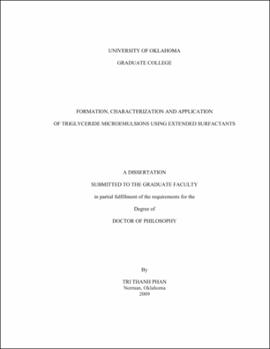| dc.contributor.advisor | Sabatini, David A | |
| dc.creator | Phan, Tri Thanh | |
| dc.date.accessioned | 2019-04-27T21:20:25Z | |
| dc.date.available | 2019-04-27T21:20:25Z | |
| dc.date.issued | 2009 | |
| dc.identifier | 99102457402042 | |
| dc.identifier.uri | https://hdl.handle.net/11244/318435 | |
| dc.description.abstract | Triglycerides are among the most challenging oils to microemulsify due to their unique structure of a bulky polar ester head and three long hydrocarbon chains. Among the published work on triglyceride microemulsions, the use of extended surfactants provides ultralow interfacial tension (IFT) and very high solubilization enhancement. However, the impacts of triglyceride and extended surfactant structure on their ability to achieve low IFT and high solubilization capacity have not been addressed fully in the literature. Applications of extended surfactant microemulsion systems are also very limited. The primary goal of this dissertation is to better understand the impacts of triglyceride structure and extended surfactant structure on their behavior in triglyceride microemulsion systems and to demonstrate the viability of using extended surfactant microemulsion system in vegetable oil detergency application. | |
| dc.description.abstract | The results show that with increasing degree of unsaturation (more double bonds), surfactant interactions with the triglycerides is weaker requiring higher optimum salinity and resulting in higher interfacial tension values. Effects of ester groups and chain length of triglyceride are also discussed and the Equivalent Alkyl Carbon Number (EACN) of the studied triglycerides and vegetable oils are reported. With regard to structure of extended surfactants, the results show that branching of hydrocarbon tail of extended surfactants lowers optimum salinity and IFT values as well as enhances triglyceride solubilization through middle phase microemulsion formation. The results also show that ultralow IFTs with vegetable oils can be achieved using extended surfactants with eight polypropylene oxide (PO) groups or more. This work also demonstrates that a microemulsion-based extended surfactant formulation is a highly viable approach for vegetable oil detergency with high oil removal efficiencies achieved at low surfactant concentration and at reduced wash temperature, an encouraging step toward "green" detergent products. | |
| dc.format.extent | 88 pages | |
| dc.format.medium | application.pdf | |
| dc.language | en_US | |
| dc.relation.requires | Adobe Acrobat Reader | |
| dc.subject | Emulsions | |
| dc.subject | Surface active agents | |
| dc.subject | Triglycerides | |
| dc.title | FORMATION, CHARACTERIZATION AND APPLICATION OF TRIGLYCERIDE MICROEMULSIONS USING EXTENDED SURFACTANTS | |
| dc.type | text | |
| dc.type | document | |
| dc.thesis.degree | Ph.D. | |
| ou.group | College of Engineering::School of Civil Engineering and Environmental Science | |
